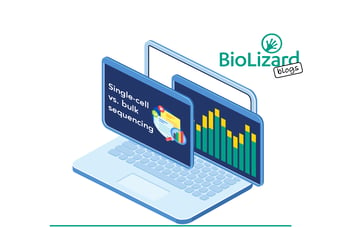When should you use single-cell sequencing?

To start off, let’s use a well-known analogy to understand single-cell sequencing better—a smoothie. When you taste a smoothie, you are never entirely certain about every single ingredient used and its quantity. But, you most certainly will recognize ‘the big chunks’ or overpowering flavours, like: bananas, strawberries, or even kale (I know what you’re thinking: ‘yuck, kale in a smoothie’).
Finding ‘the big chunks’ of a smoothie is easy, but there might be a special ingredient added in small amounts that you are unable to taste. And assuming you wanted to determine the characteristics of that special ingredient (for example, does it taste sweet or sour), it will be challenging to do so by just tasting the blended smoothie. If a tissue sample were a smoothie, single-cell sequencing could give you an accurate view of every ingredient used: by which we mean the individual cell types.
You see, single-cell sequencing allows you to study tissue biology at a single-cell resolution with high throughput. This does come with a price tag because of the higher reagent and sequencing costs. On top of that, it needs a more complex & laborious preparation protocol. To wrap it all up: handling the data analysis afterwards comes with its own unique challenges. You guessed it: it’s no walk in the park.
Before you get into a single-cell project, ask yourself if this extra level of information is desirable for you. It might be interesting for your research, it might not! This blog will help you answer that question. You’ll find out what extra information single-cell sequencing can provide and how it can be relevant to your research.
What extra information does it provide?
The best way to show you the advantages of single-cell sequencing is to go through some examples. Let’s have a look at two cases to get a clearer picture of what kind of information single-cell sequencing could provide.
1. Discovery of new cells
When you use single-cell sequencing, you could identify rare, disease-related, and unknown cell types. As mentioned before, single-cell sequencing provides a higher resolution picture of your sample.
It’s similar to using a telescope to look at the sky. With a higher resolution, you can detect stars you couldn’t see before or have a better look at the ones you already knew existed. Much like the night sky, every star looks similar in shape and size. But in reality, each star has individual properties: just like cells.
In medicine, this is why some cells might respond differently than intended during therapy—something you couldn’t possibly find out during bulk sequencing. What does this imply? Well, for instance, discovering new cell types can give you more insight into how diseases work and how our body responds to them. This helps researchers facilitate the development of therapeutic targets. An interesting example is the discovery of a new type of microglia.
2. Development of cells
It’s interesting to look at how specific cells develop over time. With single-cell sequencing, you collect biological information (transcriptome, epigenome, genome, etc..) of every cell in your sample. You could then study how they develop by putting cells into a developmental tree, for example.
As an example, let’s look at the development of cancer cells. These cells evolve through time in response to: the environment, treatment, and other factors. As a result, cells with slightly different characteristics can get triggered and grow exponentially within the same tumour. Next to that, there are other cells that have the properties to survive therapy. This is believed to be the biggest reason for relapse after cancer treatment.
Using single-cell technology makes it possible to find the needle in the haystack and capture diversity. It’s quite logical when you think about it: we know that many diseases originate from one cell. This makes researching diseases at a single cell level could be a smart move.
Here’s an interesting article on the subject.
Which research fields benefit the most?
Single-cell sequencing allows you to study complex biological systems and environments. To illustrate where single-cell sequencing plays a role in advanced biological research, we’ll go over the research fields that benefit the most.
Oncology
This shouldn’t come as a surprise since we mentioned it earlier in this blog. But single-cell technologies have created encouraging results within cancer research. Characterising single cells can help to…
… identify cells within a tumour, which are immune to therapy.
… analyse mechanisms of action for immunotherapy.
… study the tumour microenvironment and cellular response to treatment.
Understanding how diseases develop at a single-cell level creates new possibilities for precision medicine in oncology. These results and insights will hopefully save many lives.
Immunology
The immune system consists of many cell types: T-cells, B-cells, macrophages, natural killer cells, etc. Every specialised cell type has a unique function in the immune response.
Single-cell sequencing helps you to…
… detect driver genes of immunogenic response.
… understand antigen specificity.
… gain a deeper understanding of the molecular mechanisms of autoimmune diseases.

Neuroscience
The nervous system, the brain, and the spinal cord. They make up for a complex and dynamic system with different cell types such as sensory neurons, glial cells, etc. All neuro-related cells interact with one another and their environment.
Single-cell sequencing enables the study of neurodevelopment and underlying molecular mechanisms that greatly benefit the understanding of brain functionality. A mind-blowing example – pun intended – is the link between aging and neurodegeneration and increased somatic mutations in single human neurons.

Microbiology
In microbial research, single-cell sequencing – more specifically single-cell genomics and metagenomics – can facilitate…
• … the discovery of rare microorganisms.
• … a better understanding of microbial ecology and eco-evolutionary principles.
• … new breakthroughs in microbial species-species interactions, as well as host-microbiome dynamics.
Will your research benefit from single-cell sequencing?
In this blog, we’ve briefly discussed when to use single-cell sequencing. It’s important to know that the possibilities within single-cell research are almost endless.
Every project has its challenges, especially when it comes down to analysing the data. Single-cell sequencing is no exception.

Reach out for an extra pair of hands during upcoming single-cell projects!







